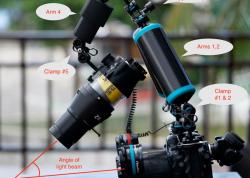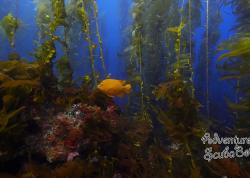Underwater Snoots 101
Snoots are commonly used in studio photography to control beams of light from a strobe or flash and narrow it to create a "spotlight" affect, or when you want to selectively light just a small portion of a scene.
The strobist says, "sometimes what makes a photo sing is not so much where the light is, but where it isn't." And that is the essence of a snoot.
In this article we document some of our first attempts using a snoot, and share some of our experiences.
Snoot with full macro attachments, placed over my port. The snoot is on my Inon Z240 strobe.
Snooting with a macro lens - first attempt
Instead of using a camera and an off-camera strobe, I decided to leave the strobes on my arms. I turned off the left strobe, and placed a snoot on my right strobe. For different shots I moved the strobe around, so sometimes the light was coming from the right, and other times it was directly overhead.
The Seahorn snoot I used did not really fit my Inon Z240 very well, so I had to hold the camera with one hand, and hold the snoot and strobe together with my right hand. It sounds difficult, but after 10 minutes on my first dive with my snoot I was able to take the following two photos, which I quite like.
Subject selection is key, and I was lucky to see a scorpionfish in just the right spot immediately after descending on the dive. Visibility was very poor, 10-15ft with particles, and I was happy to find out that using the snoot greatly cut back on the backscatter in my photos.

Scorpionfish lit by snoot. Nikon 60mm lens, small dome port. F11, 1/320th

Underwater snoot photo of a Corynactis anemone. Although the snoot effect is subtle, for this subject it creates a beautiful portrait of the anemones that has much better lighting than using a regular strobe. F11, 1/320th

Spanish shawl nudibranch, taken with snoot. 60mm lens, flat port. F11, 1/320th
Strobes and spotting lights
Using a strobe with a spotting light, also known as an aiming light, was essential for using a snoot on a strobe still attached to my camera. The aiming light does not land directly where the snoot light will land, but your mind soon learns how to calibrate between the two. When using a tripod with macro subjects, having a spotting light on the strobe is less important because your snoot will often be very close to the subject.
Snooting with a wide-angle lens
I experimented with some wide-angle shots with ambient light exposures. Looking back, I really wish I had 2 snoots on tripods so that I could fully light up the round object in the foreground of the first photo. Still, I think this photo demonstrates the possibilities when to selectively colorize and light up a wide-angle photo.

Underwater snoot photography with a Tokina 10-17mm fisheye wide-angle lens. F9, 1/100th, ISO 320

A snoot on my right side was used to light up the area in front of the scorpionfish. A fill flash was used on the left side for a little rim lighting. A snoot in a wide-angle photo can give the impression of a subject coming out onto a stage.

You can't tell from the photo, but this sheep crab was moving quite fast. I was lucky to get the light right on him. This photo would never have worked with a tripod. I tried for a vertical composition with more kelp in the background but I couldn't get one that worked,and I didn't want to overly harass the subject. F10, 1/50th, ISO 320.
Snooting with a tripod
When lighting up selected areas of a macro subject, you can no longer hand-hold the snoot, you should use a tripod. Bill Van Antwerp went to Bonaire and used a Joby gorilla tripod. Make sure the tripod is weighted, and try to find an area that has no surge. The snoot should be well fitted on the strobe, the slightest movement of the snoot will throw off the lighting.
In these examples, no spotting light was used. The end of the snoot was very close to the subject. Large amounts of patience was used.

Pikeblenny from diving Bonaire, photo by Bill Van Antwerp. Both of Bill's photos are with a Canon 7D, Canon 100mm macro lens, Subsee +5 diopter. F14, 1/160th

Arrow crab from Bonaire, photo by Bill Van Antwerp
I hope this article gives you an idea of what is possible in just a short amount of time with a snoot. With some planning and dedication, you should be able to take much better photographs than the ones in this article.
Want to learn more about snoots? Read our follow-up snoot article:
Top 5 Shooting Tips for Underwater Snoots
Further Reading
RECOMMENDED ARTICLES
SUPPORT THE UNDERWATER PHOTOGRAPHY GUIDE:
The Best Service & Prices on u/w Photo Gear
 Visit Bluewater Photo & Video for all your underwater photography and video gear. Click, or call the team at (310) 633-5052 for expert advice!
Visit Bluewater Photo & Video for all your underwater photography and video gear. Click, or call the team at (310) 633-5052 for expert advice!
The Best Pricing, Service & Expert Advice to Book your Dive Trips
 Bluewater Travel is your full-service scuba travel agency. Let our expert advisers plan and book your next dive vacation. Run by divers, for divers.
Bluewater Travel is your full-service scuba travel agency. Let our expert advisers plan and book your next dive vacation. Run by divers, for divers.


































